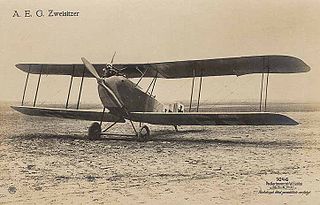
The AEG C.IV was a German two-seat biplane reconnaissance aircraft that entered service in 1916.
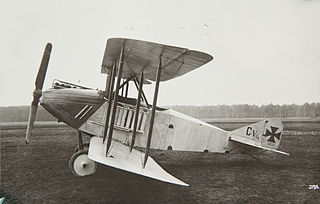
The AEG C.V was a prototype two-seat biplane reconnaissance aircraft of World War I. Designed to use a more powerful engine than previous AEG C-class reconnaissance aircraft, results were disappointing enough that further development was cancelled.

The AEG C.VII was a prototype two-seat biplane reconnaissance aircraft of World War I. It was developed from the C.IV but did not enter production. The C.VII was tested with two different wing arrangements, one with slightly tapered single bay wings and another with sharply swept upper wing.

The AEG G.V was a biplane bomber aircraft of World War I, a further refinement of the AEG G.IV. The type saw limited production before the Armistice, and never entered operational service. It featured a 600 kg (1,320 lb) bombload.
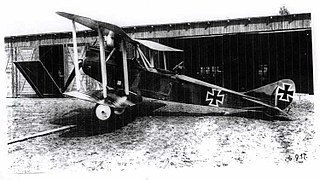
The Rumpler C.IV was a German single-engine, two-seat reconnaissance biplane. It was a development of C.III with different tail surfaces and using a Mercedes D.IVa engine in place of the C.III's Benz Bz.IV. The Rumpler 6B 2 was a single-seat floatplane fighter variant with a 120 kW (160 hp) Mercedes D.III engine built for the Kaiserliche Marine.
Number 1650 was the sole example of a unique seaplane design produced for the flying service of the Imperial German Navy during the First World War. From 1916 onwards, the Kaiserliche Werften produced a range of training seaplanes for the Navy, in order to free the nation's major seaplane manufacturers to produce front-line types. During the closing stages of the war, however, the Kaiserliche Werft Danzig and Kaiserliche Werft Wilhelmshaven produced a small number of front-line types as well, including this machine. Number 1650 was an armed reconnaissance seaplane equipped with radio equipment capable of transmission and reception, therefore gaining the naval CHFT classification.
Imperial German Navy seaplane number 947 was a reconnaissance aircraft produced during the First World War, the sole example of its type. It was one of only three armed aircraft built by the Kaiserliche Werft Wilhelmshaven amongst a variety of trainer seaplanes that they had produced for the Navy during the course of the war. Number 947 was a two-bay biplane of conventional design, with twin pontoon undercarriage, and two open cockpits in tandem. It received the Naval classification CHFT, indicating an armed aircraft equipped with radio gear capable of both sending and receiving.

The Rumpler B.I was a military reconnaissance aircraft produced in Germany during World War I.

The Rumpler C.III was a biplane military reconnaissance aircraft built in Germany during World War I.
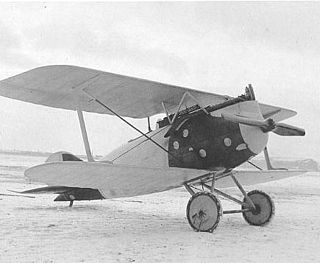
The Rumpler D.I was a fighter-reconnaissance aircraft produced in Germany at the end of World War I. It was a conventional single-bay biplane with wings of unequal span braced by I-struts. It featured an open cockpit and a fixed, tailskid undercarriage. The upper wing was fitted with aerodynamically balanced ailerons and fuselage had an oval cross-section.

The Rumpler G.I was a bomber aircraft produced in Germany during World War I, together with refined versions known as the G.II and G.III.
The Sablatnig SF-1 was a reconnaissance seaplane built in Germany during the First World War.
The Sablatnig SF-2 was a reconnaissance seaplane produced in Germany during the First World War.
The Siemens-Schuckert R.I was a bomber aircraft built in Germany during World War I. It was originally ordered as the Siemens-Schuckert G.I prior to the German Inspectorate of Flying Troops adopting the "R" classification for multi-engine aircraft in late 1915. Some sources refer to the aircraft as the Siemens-Schuckert Steffen R.I, including the name of the brothers that designed it.
The Siemens-Schuckert R.III was a prototype bomber aircraft built in Germany during World War I. It was one of six aircraft based on the Siemens-Schuckert R.I that were originally intended to be identical, but which each developed in a different direction and were designated as different aircraft types by the German Inspectorate of Flying Troops. The aircraft's development was impeded by the unreliability of its Maybach HS engines, and when it was eventually accepted for military service, it was only in a training role.
The Siemens-Schuckert R.V was a bomber aircraft built in Germany during World War I. It was one of six aircraft based on the Siemens-Schuckert R.I that were originally intended to be identical, but which each developed in a different direction and were designated as different aircraft types by the German Inspectorate of Flying Troops. Development of the R.V benefited from the experience that Siemens-Schuckert and the Idflieg had gained with the R.II, R.III, and R.IV, particularly in its choice of powerplants, where the R.V was spared from the troublesome Maybach HS engine. Between September 1916 and February 1917, the aircraft saw service on the Eastern Front before it was damaged in an accident and dismantled for spare parts.
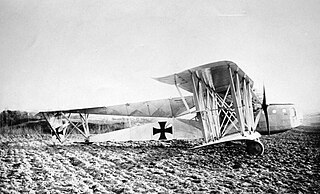
The Siemens-Schuckert R.VI was a bomber aircraft built in Germany during World War I. It was one of six aircraft based on the Siemens-Schuckert R.I, which were originally intended to be identical. Each developed in a different direction and were designated as different aircraft types by the German Inspectorate of Flying Troops.

The Siemens-Schuckert R.VII was a bomber aircraft built in Germany during World War I. It was one of six aircraft based on the Siemens-Schuckert R.I that were originally intended to be identical, but which each developed in a different direction and were designated as different aircraft types by the German Inspectorate of Flying Troops.

The Albatros C.IX was a two-seated German military reconnaissance biplane from 1917. It was built by Albatros Flugzeugwerke. It did not have a central strut between the upper wing and the fuselage, which was uncommon during the time. Also unusual was that the top wing was swept, while the lower wing was straight. Only three of these aircraft were built.

The Rumpler C.X, produced under the company designation Rumpler 8C 14, was a German two-seat observation aircraft. It was developed from the earlier Rumpler 8C 13 prototype by Rumpler in early 1918. The prototype had a similar wing design to the Rumpler C.VII, powered by a 260 hp (194 kW) Mercedes D.IVa engine and was later powered by a 240 hp (179 kW) Maybach Mb.IVa. The C.X had the highest top speed and service ceiling of all German C-type aircraft and an order was placed for the aircraft in August 1918, but few were built and tested before the war ended.













